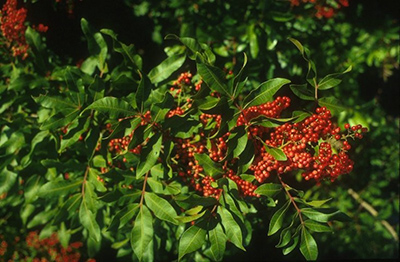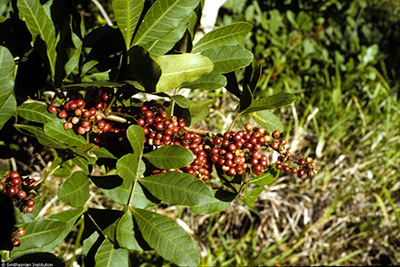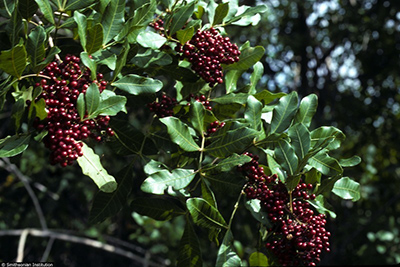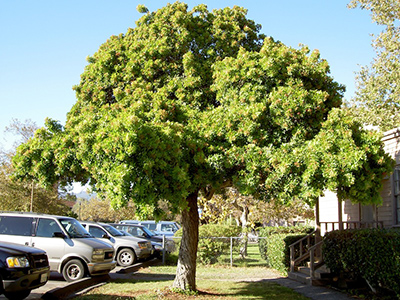
Eradication of Brazilian pepper not simple
The Brazilian pepper tree is one of the most widespread and powerful invasive species in the Florida Everglades, and is spreading to other parts of the country, mainly the Southwest United States. It has yet to be eradicated by human methods.
When the Everglades were visited by early settlers in the late 1800s and early 1900s, the area was thought to be worthless and it needed to be drained to be developed.
| These berries on a Brazilian pepper tree are under ripe because of their light red color (Photo courtesy of the National Park Service). |  |
However, in 1947, Congress passed a law to create Everglades National Park to protect the region. Florida wetlands have since shrunk throughout the years and many exotic species have taken over the Everglades.
Invasive species are non-native plants or animals that have detrimental effects on the ecosystems around them. They are unnatural to the area, so eradication and control is difficult due to lack of knowledge about the species. Invasives can hurt food chains, destroy habitats and even speed up extinction of endangered species.
They can also negatively impact the economy, because extra money is taken from budgets to not only research the species, but to find ways to remove it. Although they mainly affect other species in an ecosystem, humans are not immune to their effects.
Other than the Brazilian pepper tree, the main invasive species in the Everglades are the white bottlebrush tree, the Australian pine tree, the water orchid and the Florida waterweed.
 |
The grass below the tree is undernourished due to the plant taking necessary groundwater (Photo courtesy of the National Park Service). |
“The pepper tree is one of the more aggressive invasives that we have to deal with,” Mary Plumb, the Public Affairs Officer for the National Park Service stated.
The Brazilian pepper tree originated in South America, specifically Brazil, Argentina, and Paraguay, and was introduced to America in the 1840s for use as a cultivated ornamental plant. Many people called them “Florida Christmas holly” and kept them in their homes.
It is a member of the same family as poison ivy and poison oak. Human contact with the leaves has the potential to cause skin irritation or a light rash.
It is described as a bushy, spreading evergreen with multiple branches that form a tight yet tangled mass. There are small clusters of lightly colored flowers and red berries on the leaves, and the berries are able to spread seeds upon hitting the ground.
It is very sensitive to cold weather, so it colonizes in warm and humid climates. It is abundant in native tree hammocks, pine flatlands and mangrove forest communities. It is the most aggressive non-native plant in Florida, covering more than 700,000 acres of land in the state alone.
| Berries of this dark red color can cause skin irritation if touched (Photo courtesy of the National Invasive Species List). |  |
Birds and animals widely distribute their seeds, and it is completely resistant to natural disasters (such as flooding, fires, and drought). It can grow up to 10 feet per year, and re-sprout if cut down. The tree does not need water or extensive sunlight to grow, which makes it abundant in any type of climate. It has no natural predators in Florida, and can grow in any type of soil with varying degrees of salinity.
“Eradicating the tree has always been a struggle, as it doesn’t react to biological controls,” said John Pipoly, the Extension Agent of the Urban Horticulture Section of Broward County Parks on an interview on a website.
The pepper tree is ranked a Category 1 invasive species (out of three categories, it is the most concerning) and is on the Florida Noxious Weed and Florida Prohibited Aquatic Plants Lists. It has many detrimental effects on the areas it takes over. It is illegal to cultivate, sell, or transport them.
“It is extremely difficult to eradicate, because the only way to completely remove it is to destroy the entire plant along with its root,” said Elaine Remillet, a correspondent for Broward County. If any part of the root remains, it can grow new seeds and create even more trees and shrubs.
Some herbicides have been useful in controlling it, but the only herbicides that can completely destroy it contain chemicals that can have hindrances on many other parts of an ecosystem. Two types, named Glyphosate and Triclopyr, have been found as helpful in controlling it.
“Because it is such a large plant, the only way it can be removed is mechanically,” Biological or physical control can only temporarily remove the invasive species and balance its effect.a
 |
A Brazilian pepper tree (Photo courtesy of the U.S. Department of Agriculture). |
A mechanical method of control that has been introduced involves treating the stump. The trunk needs to be as close to the ground as possible, and the surface of the stump is immediately treated with a chemical herbicide. The best time to cut them is the season that they are not growing fruit, so that the seeds cannot sprout into new trees.
Another recent method involves applying herbicide to the bark, about two feet off of the ground. However, this method of control takes one to two weeks to show effects of control. Signs of control include defoliation of the tree and termite presence.
The main detrimental effects of the Brazilian pepper tree are that it can kill other vegetation rapidly by forming dense connections with their branches, which suppress growth of smaller plants. Once they take over one area, their strong roots cannot be permeated.
Due to its large volume on the ground, it takes over the food and shelter of other plant and animal species, such as snakes and many amphibians. It disturbs fish-breeding habitats, crowds mangroves and promotes erosion, thus hurting shorelines.
Although the Brazilian pepper tree is a powerful force against the Everglades and its fragile ecosystems, the tree is being researched extensively. Many control methods (such as herbicides and mechanical controls) have been discovered by invasive specialists.

Comments are Closed